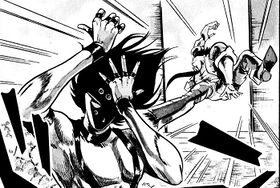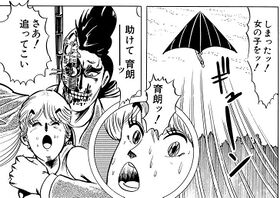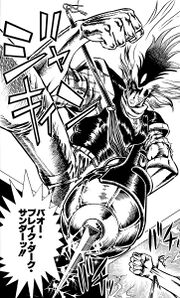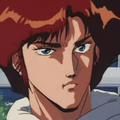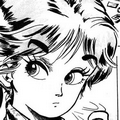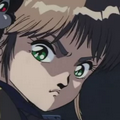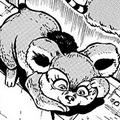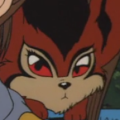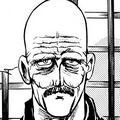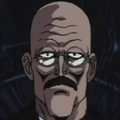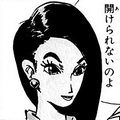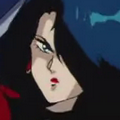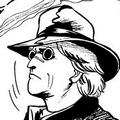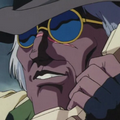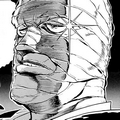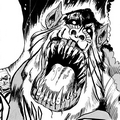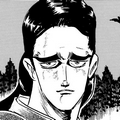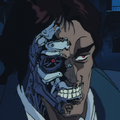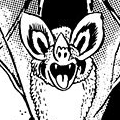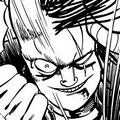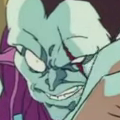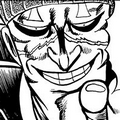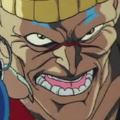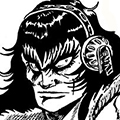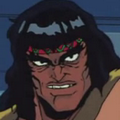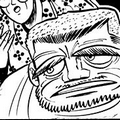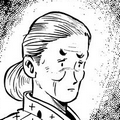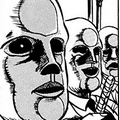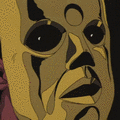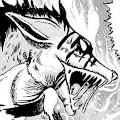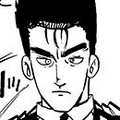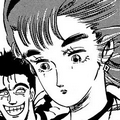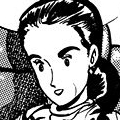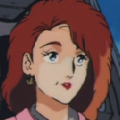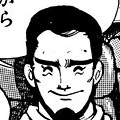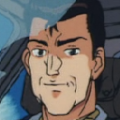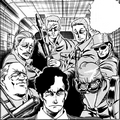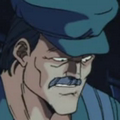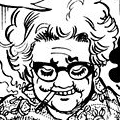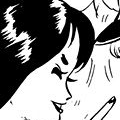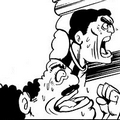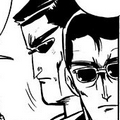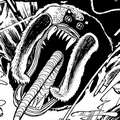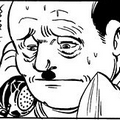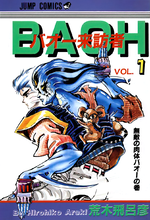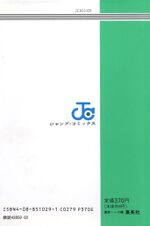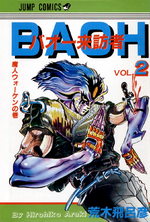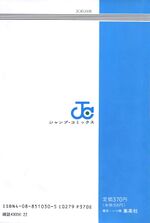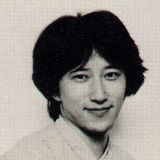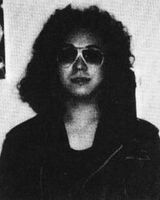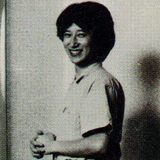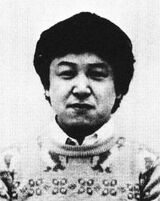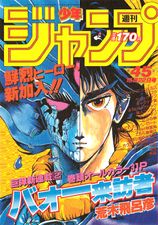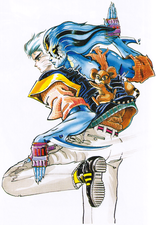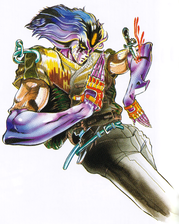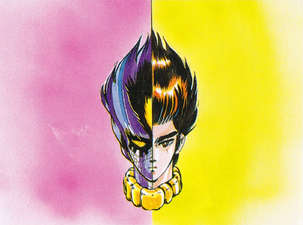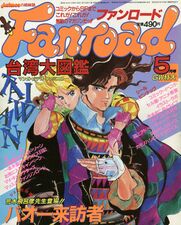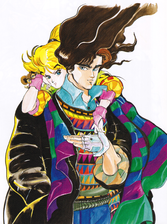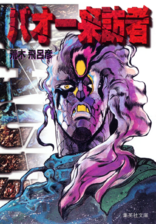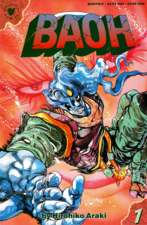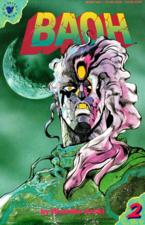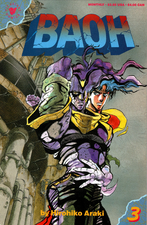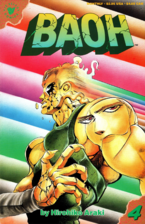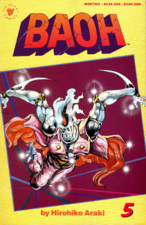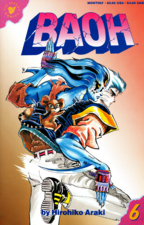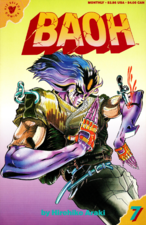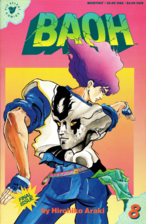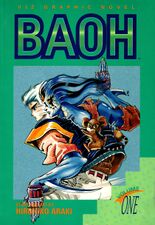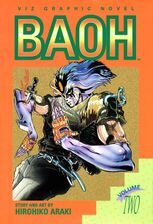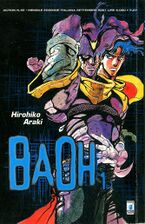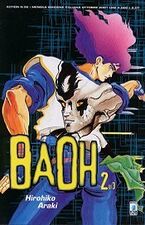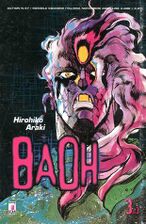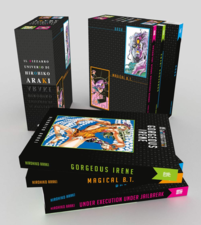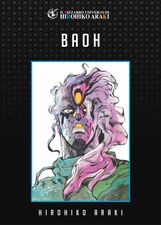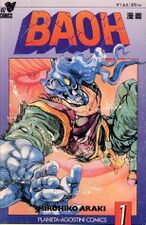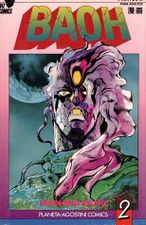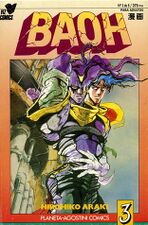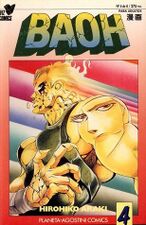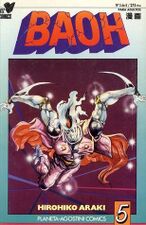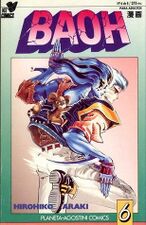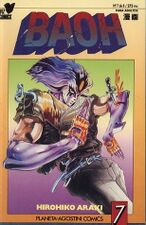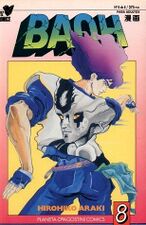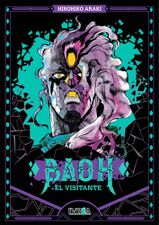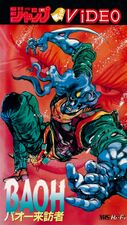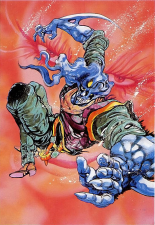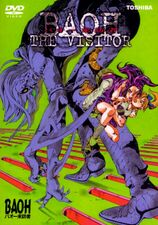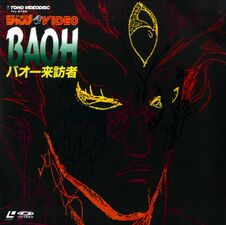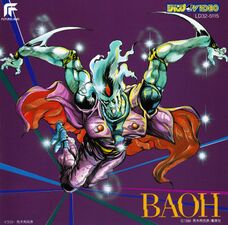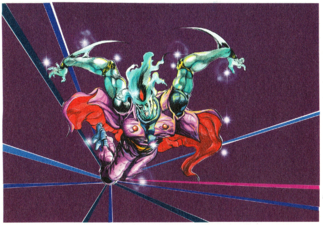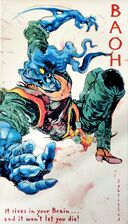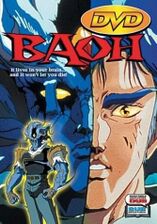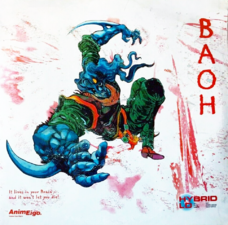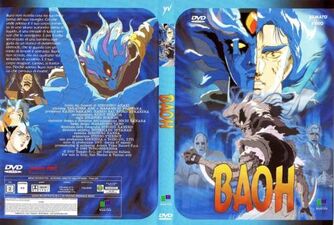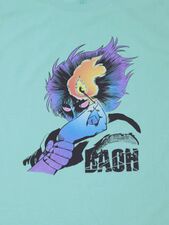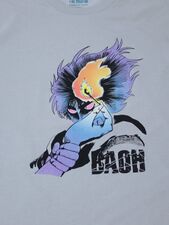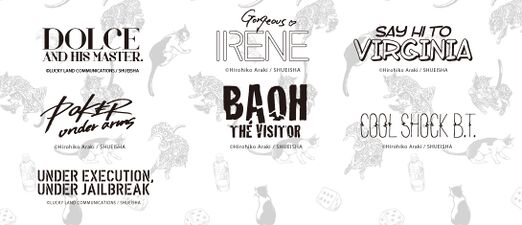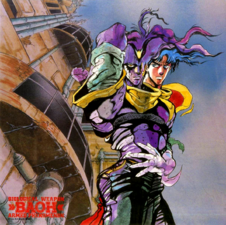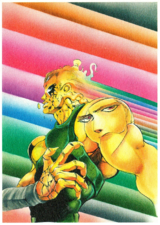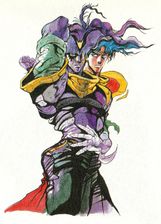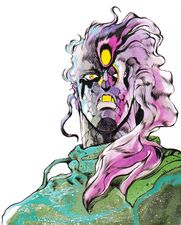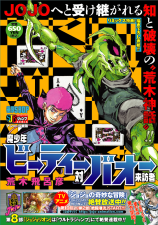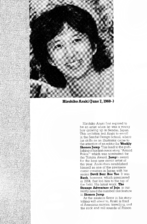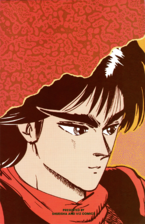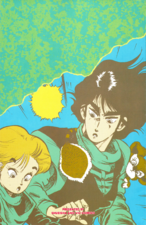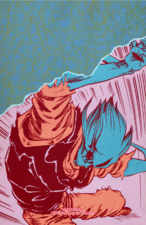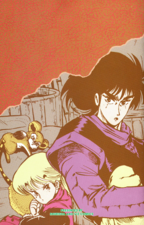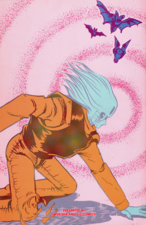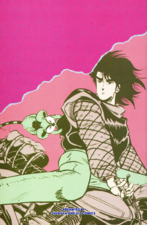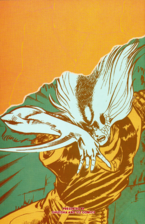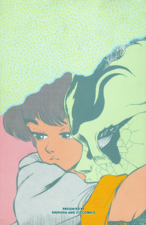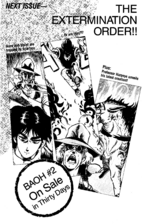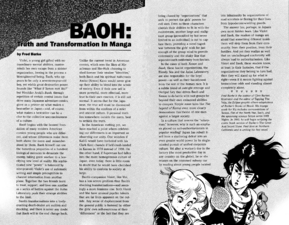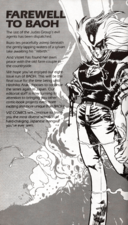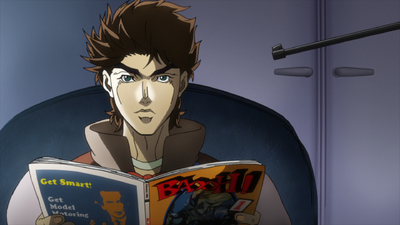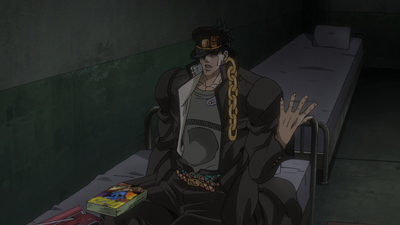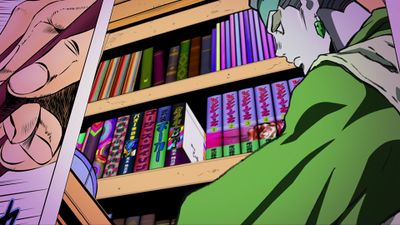Baoh the Visitor
Baoh the Visitor (バオー来訪者, Baō Raihōsha) is a manga written and illustrated by Hirohiko Araki. It was originally serialized in Weekly Shonen Jump with seventeen chapters from October 1984 to February 1985. In September 1985, it was compiled into two tankōbon volumes with nine chapters. It later released as one bunkoban volume on June 16, 2000.[2]
The manga was licensed in English and released in monthly chapter issues by VIZ Media in 1990. As it was financially unsuccessful, it was not until 1995 that it was re-released in a volume format.[3] An OVA adaptation of the series by Studio Pierrot released on September 16, 1989.
Seventeen-year-old Ikuro Hashizawa can transform into the parasitical bio-weapon, Baoh, gaining superhuman strength and other abilities such as emitting corrosive substances and discharging electricity. He escapes from the secret Dress Organization along with a young psychic girl, Sumire, and the two must face various assassins sent by the organization to kill him.
Summary
Prologue
One day, the mangled corpse of a woman washes up on a northeastern shore of Rikuchu, Japan. The dead woman is revealed to have been on a certain train several days earlier.
On said train, Dr. Kasuminome of the Dress Organization, a covert government group responsible for creating secret weapons, escorts one of his latest creations, Baoh, kept dormant in a tank. Meanwhile, a little psychic girl named Sumire, who was kidnapped to be studied, escapes from her room. During her escape, she releases Baoh, revealed to be a young man with superhuman abilities. Baoh and Sumire subsequently escape the train, and Kasuminome fears that he may have unleashed a terrible weapon on the world before its prime.
Ikuro on the Run
Kasuminome immediately calls for an assassin to kill Baoh. Later, the boy and Sumire try to bond with each other, but a knife wielding assassin named 22nd Man stabs the former, forcing the duo to steal a motorbike and flee. The assassin reports his failure, and is ordered to gather more of his comrades to finish off Baoh before his power fully awakens. It is revealed that the boy, Ikuro Hashizawa, doesn't remember how he obtained his uncanny strength and regeneration. 22nd Man soon attempts a second murder, slicing Ikuro's throat, but it only awakens Baoh, who dissolves the assassin before returning to human form.
Later, a death squad is already searching for Ikuro and Sumire, who are busy betting on horse races to acquire money. Meanwhile, Kasuminome explains to his sponsors the Baoh parasite, which grants supernatural strength and abilities to its host, growing in power the longer it stays within them. To demonstrate its potential, he pits a little Baoh dog against a tiger, a battle which the dog handily wins before being put down. If the parasite within Ikuro were to reach its imago stage, it would lay its eggs within his body and threaten to spread across the world. Meanwhile, Ikuro and Sumire have settled inside an abandoned building, Ikuro sensing that something inside of him is changing. The death squad attacks the duo, but Ikuro transforms again into Baoh, decimating the squad. Unbeknownst to him, he is observed by another assassin.
Baoh senses the assassin, who reveals himself as a beastmaster commanding a heavily modfied giant mandrill named Martin. Due to its strength and many weapons hidden inside his body, Martin is more than a match for Baoh. Sumire, having sensed that Ikuro's humanity is still intact inside of Baoh, tries to stop the assassin from controlling Martin, only to be hurt. Enraged, Baoh finally overpowers Martin and kills both the beast and his master, healing and turning back into Ikuro.
Sumire Taken Hostage
Walking through the mountains, Ikuro explains to Sumire that after a deadly car collision, Ikuro and his parents were heavily injured and taken to the hospital six months ago. Unfortunately, the doctor was linked to Dress, looking for guinea pigs at the time. Kasuminome callously killed Ikuro's parents under his eyes and took him away to inject the Baoh parasite inside of him. Back to the present, an old couple living in the area gives Ikuro and Sumire shelter and food. But during a moment the old man, Rokusuke, is isolated, Dress's Lieutenant-Colonel Dordo hypnotizes the old man into shooting Ikuro in the head with his hunting rifle at the stroke of midnight.
Dordo watches the house until midnight strikes. Rokusuke wakes up and tries to shoot Ikuro, who transforms into Baoh but senses that the old man is not his true enemy. Jumping through the roof, Baoh confronts Dordo, who disables all of his sensory organs through chemicals released by a swarm of Aroma Bats. Thankfully, Rokusuke has come to his senses and, guided by Sumire, shoots down the bats despite taking a bullet. Baoh confronts Dordo and mortally wounds him, only to reveal his heavily-modified cyborg body. The unharmed Dordo kidnaps Sumire to use her as bait, and escapes with a delta plane to one of Dress's headquarters near Sanriku. Ikuro is determined to free Sumire, but risks unleashing the beast inside of him for good.
Going away on a motorcycle given by the couple, Ikuro deems it necessary to learn to control his power first to have a chance to save Sumire. Meanwhile, Kasuminome chastises Dordo for his perceived failure and the danger of giving Baoh time to grow stronger. Meanwhile, Ikuro is forced to save a trapped girl from a speeding train and is pushed into managing to activate his acid touch without fully transforming. Humiliated by his hierarchy, Dordo goes out to snipe Ikuro, but his attempt is foiled when Ikuro harnesses Baoh's super senses and strength to evade the bullets without transforming. Meanwhile, Sumire is experimented on, but the scientists cannot make her cooperate. Sumire is terrifed at the sight of a hulking Native American named Walken, however—Walken's extraordinary psychic powers allow him to manipulate and destroy objects at a molecular level, making him one of the most dangerous men in the world.
Ikuro vs. Walken
Taken back to the headquarters, Dordo is executed by Walken for his failure, being atomized into dust. To lure Baoh, Kasuminome purposefully tortures Sumire, whose distress is detected by Ikuro. Transforming into Baoh once more, Ikuro scales the seaside cliff leading to a vulnerable side of the facility and rampages through the security staff and Kasuminome's deadly traps. He is soon confronted by Walken, who corners Baoh by trapping his arm within a wall. Nonetheless, Baoh manages to stab Walken's brain by slicing off his trapped arm and launching one of his arm blades, tearing the warrior's limiter headband in two in the process.
With Walken defeated, Baoh finally reaches Sumire, only to be welcomed by a flurry of laser beams targeted at Sumire. Baoh rescues Sumire, healing her wounds from the attack with his blood. Seeing that Baoh is cornered, Kasuminome sets the facility's self-destruct sequence in motion. As Kasuminome rushes to his escape pod, the other scientists encounter Walken during their escape, his power and thirst for revenge now beyond measure. As Sumire awakens, Walken finds her and Baoh, destroying the floor beneath them. All three of them, as well as Kasuminome within his escape pod, fall into the limestone cavern beneath the facility. After telling Sumire to flee, Baoh uses one of the lasers from her torture chamber to slice Walken in two, fatally wounding Kasuminome with a fallen stalactite in the process. The cavern then collapses as the facility self-destructs, putting an end to both Dress and its final creation.
Naturally, the explosion received little attention on the news, the cause being attributed to a pharmaceutical company's mishandling of materials. The Dress Organization was never mentioned. Some time later, an older Sumire has been taken in by the old couple and given a new, happier life. She senses that Ikuro is dormant, but alive, waiting at the bottom of the sea. When she turns seventeen, Sumire confidently predicts, he will reawaken and return to her.
Characters
Volumes
- Baoh, the Ultimate Weapon (最終兵器バオー, Saishū Heiki Baō)
- The Extermination Order! (抹殺指令!, Massatsu Shirei!)
- Baoh, the Invincible Body (無敵の肉体バオー, Muteki no Nikutai Baō)
- Evil Beast Martin (凶獣マーチン, Kyōjū Māchin)
- Grandpa Rokusuke (六助じいさん, Rokusuke-jīsan)
- Baoh, the Ultimate Weapon (最終兵器バオー, Saishū Heiki Baō)
- The Extermination Order! (抹殺指令!, Massatsu Shirei!)
- Baoh Dog (バオー
犬 , Baō Doggu) - The Invincible Body (無敵の肉体, Muteki no Nikutai)
- The Odor of Murder (殺意の
におい , Satsui no Nioi) - Evil Beast Martin (凶獣マーチン, Kyōjū Māchin)
- Artificial Evolution (人工進化, Jinkō Shinka)
- Grandpa Rokusuke (六助じいさん, Rokusuke-jiisan)
- Aroma Bat (アロマ・バット, Aroma Batto)
- Come Out, Baoh (
怪物 よ出でよ, Baō yo Ide yo) - Cyborg Lieutenant Colonel Dordo (サイボーグ・ドルド中佐, Saibōgu Dorudo-chūsa)
- Demon Walken (魔人ウォーケン, Majin Wōken)
- Aroma Bat (アロマ・バット, Aroma Batto)
- Cyborg Lieutenant Colonel Dordo (サイボーグ・ドルド中佐, Saibōgu Dorudo-chūsa)
- Come Out, Baoh (
怪物 よ出でよ, Baō yo Ide yo) - Demon Walken (魔人ウォーケン, Majin Wōken)
- Molecular Vibration! (分子振動!, Bunshi Shindō!)
- The Nepenthes Trap (ネペンテスの罠, Nepentesu no Wana)
- The Warrior's Warpaint (戦士の化粧, Senshi no Keshō)
- The Last Trump Card (最後の切り札, Saigo no Kirifuda)
- Submerged in the Darkness! (闇に沈め!, Yami ni Shizume!)
Adaptations
OVA
The series was adapted into a single-episode original video animation (OVA) by Studio Pierrot in 1989; licensed for an English DVD release by AnimEigo in 2000, delayed until finally released in 2002.
Author's Note
Volume 1
予知とか念力とかは、ある程度やると飽きてしまうと思います。でも変身はきっと楽しいよ。他人をからかったり、いろいろな所へ行ったり……。きっと一生飽きずに遊べると思うな。そんなわけで『バオー来訪者』をどうぞ。カッコイイけど悲しいお話なんです。
Many readers expect direct stimulation every week, and only want to see the results of the main character's actions, so the science fiction sensibilities sprinkled throughout the work and the calculated sense of wonder created by the main character are usually overlooked as part of the atmosphere. Nonetheless, this is precisely where a science fiction writer gets to put their skills to the test, trying to visualize what we can only see in our wildest dreams. I mentioned earlier that our "scents" were similar. That's because I felt that his approach to drawing manga was very close to mine. There are very few artists who can make sci-fi manga entertaining without compromising the overall quality of their work, and Araki is one of them. I think that he'll continue to grow as a manga artist in the future while retaining his distinctive "scent."
It's important to recognize that science fiction manga isn't the same as novels or films. At first, this seems obvious, but I think it's something necessary to keep in mind. I hope the both of us will continue drawing science fiction manga until we truly understand what it means.彼は何よりもまず、ストーリー展開を何度も緻密に練りあげてから構成していく。人間関係はもちろん、それを取り巻く状況、センス・オブ・ワンダーをどこに置くかなど、すべてを完壁に把握した上でなければ語り出さないタイプだ。とはいっても、これは小説や脚本を書くのと同じ手法であって、連載マンガ家としては非常に不利な一面を持っている。
多くの読者は毎週の直接的な刺激を期待し、主人公の行動結果のみを求めるあまり、画面の中にちりばめられたSF的感性や主人公の中にある計算されたワンダーに、すべては大気のように気づかれず読み落とされる場合が多い。
しかし、SF作家はそこにこそ自らの資質をつぎ込み、自分の白中夢を映像化しようとこころみる。
先に、彼と僕は同じ
SF漫画において、作品の質を低下させずになおかつ、エンターテイメントであろうとする作家は数少ない。彼はもちろんその中のひとりであり、今後、今の
SF漫画にSF小説でもSF映画でもない。あたりまえのことのように思えるが、SF漫画を描く上ではこの認識が最も重要であり、難しいものだと思う。
Volume 2
スティング(ミュージシャン)、マドンナ、ナスターシャ・キンスキー、ガッチャマンのジョー、カムイらの目は特に謎めいていて、大好きです。みんなカッコイイ!
If the persuasive power of a novel comes from its style, the persuasive power of a manga comes from its drawings. It's all about what kind of pictures you can present before the reader's eyes. The persuasiveness of those drawings is the persuasiveness of the manga itself. The small details fade away.
In that regard, when I laid eyes on the drawing of the Baoh parasite, I was struck by its eeriness—in other words, its persuasive power. When the reader is presented with such a drawing, they simply have to trust the author. Masaki Yamada once wrote that "science fiction is description," and I believe that manga is a form of description as well.
A sequel to this story will undoubtedly have to be drawn before long.小説の説得力が"文体"によって生まれるのなら、漫画の説得力は"絵"であると思う。どのような"絵"を読者の目の前に差し出せるかである。その"絵"の説得力が、そのまま、その漫画の持つ説得力になる。小さな理屈はどこかに消えてしまう。
そういう意味で、寄生虫であるバオーの"絵"を見た時、その不気味さ、つまり説得力にぼくはうなってしまった。このような"絵"を見せられれば、読者はその作家信用してしまうのである。「SFは描写だ」と、山田正紀氏(SF作家)が何かに書いていたが、漫画も描写であるとぼくは思う。
Afterword
However, at the time Baoh began serialization in 1984, courier services had barely been established in Sendai, so my work schedule was already constrained. I didn't want to move to Tokyo in the summer because of the hot and humid weather, as well as the small size of the place (which I'm still not used to), but after some encouragement I took the plunge. And now, looking back, I can only remember the positives of coming to Tokyo.
Firstly, the people there were human, too. I got to know people with different ideas and information, and was shocked at the different ways of looking at things, and being able to see and hear new things was the biggest plus in terms of studying. There were books on sale by painters and designers I had never seen before, and I became obsessed with food I had never eaten before. I really admired the painters Frank Frazetta, Enki Bilal, and Antonio Lopez. I was surprised by the beauty and fashion sense of designer stores like Missoni and Versace. I also watched MTV shows late at night, and I got to see performances of Madonna and African American rap music for the first time. I brought the question I had been pondering since my previous work, Cool Shock B.T., with me to Tokyo: "How can I develop my own art style?" As I studied, I realized I had a lot of work to do.
The idea for Baoh the Visitor came to me while I was working in Sendai. Since I had depicted an "intellectual conflict" in Cool Shock B.T., I thought about creating a setting and protagonist based on the theme of "the body" for my next work. I wanted to write a story about the topic of creating biological weapons using the cloning and genetic engineering techniques already available in 1984. The abilities used by the protagonist had to be sufficiently biological and logical, even if they were exaggerated. I also wanted to depict the story's progression with a similar rhythm to rock music. That's what it felt like to me, anyway. It had to be like the groove I'd seen on MTV since I came to Tokyo, full of the shrieks, the crescendos, the "Barubarubarubaru!" of life.
Once serialization began and the story progressed, I began to feel that, while genes could be a strange and wonderful concept, there's also something sad about them. Perhaps something like fate exists within one's own genes. For around ten years after its conclusion, I was often asked whether I would continue Baoh the Visitor. However, I think it's best to keep the end of Baoh here. The heroine, a young girl, grows up with a sense of hope for the future. I drew the last chapter with the feeling that the future is driven by hope, and I believe this "ode to life" was inherited by a work I started two years later, JoJo's Bizarre Adventure. In regard to that art style challenge I had during my Cool Shock B.T. days, I wonder if I'll continue to study and hone my skills from here on? In that regard, I'm hopeful for the future.
I lost the manuscript for the full-color illustration of this book at some point, probably when the Shueisha building was being renovated, and I haven't been able to find it since. That's why I decided to use a magazine cover from the time of its publication. In other words, the original cover doesn't exist anymore...でも『バオー』連載時の一九八四年当時は、やっと宅配便のシステムが出来た程度で、故郷で仕事するのは、時間的にもう限界に来ていた。夏、あついのはヤだし、土地は狭そうだし(現在でもけっこう慣れてない)上京するのはいやだったけれど、背中をドンと押されて上京したというわけだ。
そして今、思い返すと、上京して良かったと思う点しかあがらない。
まず、やっぱり人間だ。いろんな考えや情報を持った人と知りあえて、いろんな物の見方にショックを受けて、見たり聞いたり出来たので、勉強という点では最大にプラスになっている。見た事もない画家やデザイナーの本が売ってるし、食べた事もない料理に夢中になった。
フランク・フラゼッタとかエンキ・ビラル、アントニオ・ロペスといった画家は、本当に好きになった。ミッソーニとかヴェルサーチといったデザイナーの店の美しさやセンスのよさにビックリした。それと、MTVのテレビ番組も深夜やってて、マドンナとか黒人ラップとかも初めて見た。
わたしの前作『魔少年ビーティー』からの作品的な課題で「自分なりの絵をどう描くか?」それをひきずって上京したわたしは、研究したり勉強したり「やる事がいっぱいあるなあ」と思った。
『バオー来訪者』のアイデア自体は、仙台の時からあって、「魔少年ビーティー』で「知力」の闘いを描いたから、次作は「肉体」をテーマにして設定と主人公をつくってみようと思っていた。一九八四年当時
そして連載が始まり、どんどん話をすすめていくと、描いているうちに「遺伝子」ってなんて不思議でスバらしいメカニズムであると同時に、なんか悲しいところもあるなあと感じるようになって来た。たぶん、運命のようなものが遺伝子の中に存在するからかもしれない。
よく『バオー来訪者』の続きは描かないのですか?と、完結後10年くらい言われた。でも、『バオー』のラストは、ここで「終わり」を保っとくのが一番いいと、自分では思っている。主人公の女の子が、希望をいだきながら成長していく。未来のことは希望の中にこそあると、自分は描いている途中で感じ、そしてこのラストは、生命の讃歌として、この2年後の作品『ジョジョの奇妙な冒険』が受け継いでいると自分では思う。
最後に「自分なりの絵をどう描ーか?」という『魔少年ビーティー』からの課題も、これからもずっと研究して修業していくのかな? と希望の中に思っているというわけ。
Gallery
Trivia
- Baoh was Araki's first successful manga series and allowed him to afford his first trip abroad, to England. However, Araki found the trip difficult as he didn't understand English and wasn't familiar with the food.
- The setting of England would, however, later be used for Araki's next successful manga series, JoJo's Bizarre Adventure.[5]
- According to Araki, the name "Baoh" comes from the term "Bio" as in Biotechnology, which was a hot topic at the time of Baoh's publication.[6]
- VIZ planned to bring JoJo's Bizarre Adventure to America in the early 1990s. They ran a blurb about it in their promo newsletter Viz-In under the name "The Strange Adventures of JoJo".[7] However, the plan collapsed when Baoh sold poorly in America.[3]
- In June 1998, Akira Toriyama ranked Baoh the Visitor as his #2 Weekly Shonen Jump manga.[8][9]
- Hiroyuki Takei, the manga artist of Shaman King, said that Baoh the Visitor was one of his favorite series along with JoJo's Bizarre Adventure in his youth.[10]
Cameos
- In Episode 10 of JoJo's Bizarre Adventure, Joseph is seen in a flashback reading Baoh (the same scene in the manga used Superman). The title, however, is written as "Baooh", with two O's.
- Baoh (Ikuro Hashizawa) appears as a DLC guest fighter in All-Star Battle and All-Star Battle R.
- In Episode 1 of JoJo's Bizarre Adventure: Stardust Crusaders, Baoh is on the cover of a Weekly Shonen Jump magazine that Jotaro Kujo reads in his jail cell.
- During the ending sequence of the Diamond is Unbreakable song, "I Want You", a copy of Baoh can be spotted on Rohan Kishibe's bookshelf.
- Baoh appears in JoJo's Pitter-Patter Pop! as a decoration in the Comfortable Jail Series furniture.
Notes
- ↑ Some chapters were fused together for volumization.
References
- ↑ Baoh the Caller - IMDb
- ↑ https://www.amazon.co.jp/-/en/荒木-飛呂彦/dp/4086174863
- ↑ 3.0 3.1 AnimeNewsNetwork
- ↑ 4.0 4.1 http://jinbei.s58.xrea.com/data_book_araki4.htm
- ↑ Kappa Magazine (December 1996)
- ↑ Interview with Hirohiko Araki - JoJo 6251, p.170
- ↑ Baoh: The Visitor Issue #1 English Author's Note
- ↑ Weekly Shonen Jump 1998 No. 31, Shueisha. Image.
- ↑ JoJo's Bizarre Encyclopedia [@jojo_wiki] (March 11, 2024), "Akira Toriyama's Best 3 Jump Manga (1998)", on Twitter / X.
- ↑ Hiroyuki Takei Interview
